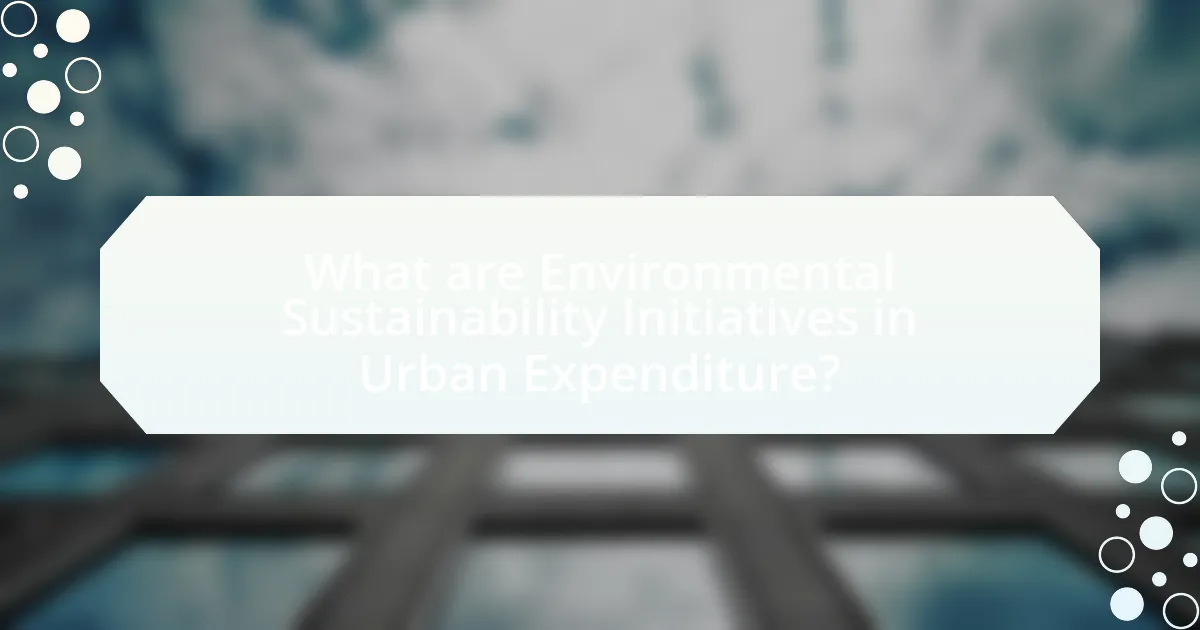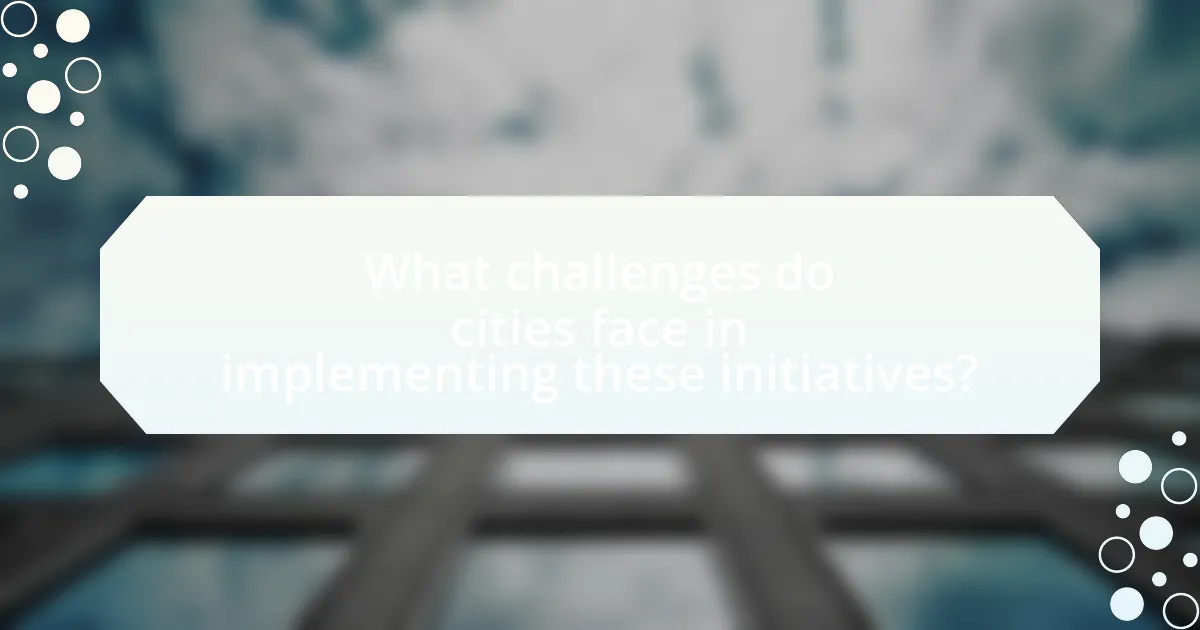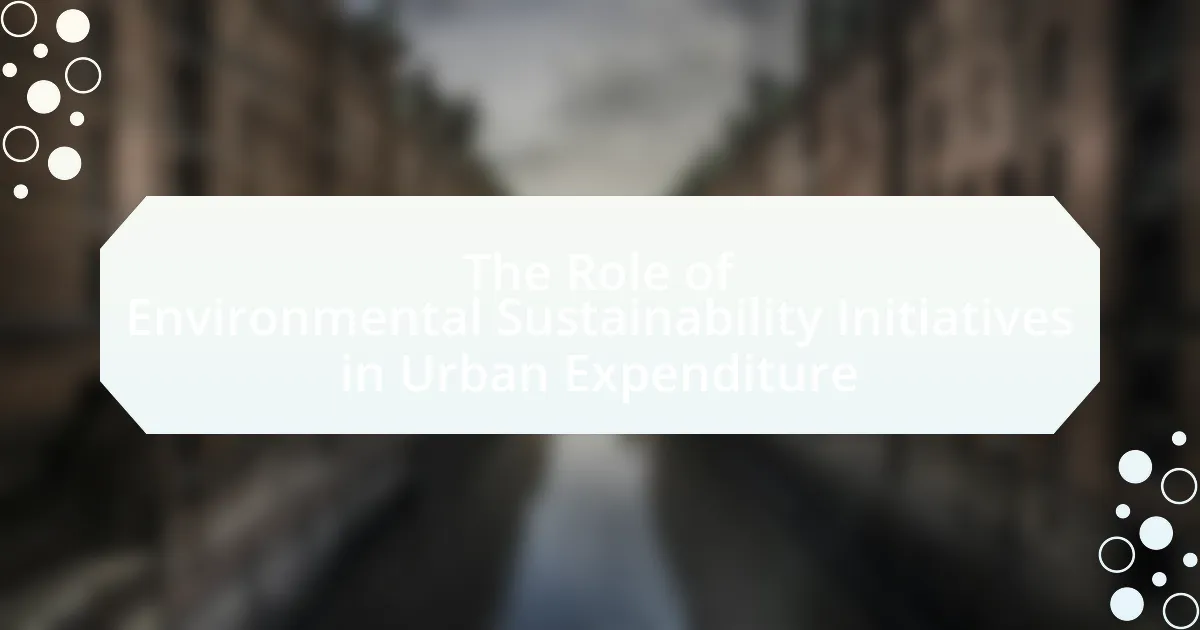Environmental sustainability initiatives in urban expenditure encompass programs and policies designed to promote ecological balance and efficient resource management in urban areas. These initiatives include investments in renewable energy, sustainable transportation, waste reduction, and green infrastructure, significantly impacting urban financial planning by reallocating resources towards sustainable projects. Key components such as resource conservation, community engagement, and renewable energy adoption influence urban expenditure decisions, leading to long-term economic sustainability and improved quality of life. However, cities face challenges like budget constraints and regulatory complexities that can hinder the implementation of these initiatives. Effective public engagement and innovative funding models are essential for overcoming these barriers and enhancing the success of sustainability efforts in urban environments.

What are Environmental Sustainability Initiatives in Urban Expenditure?
Environmental sustainability initiatives in urban expenditure are programs and policies aimed at promoting ecological balance while managing urban resources efficiently. These initiatives often include investments in renewable energy, sustainable transportation systems, waste reduction strategies, and green infrastructure development. For instance, cities like San Francisco have implemented zero waste policies, aiming to divert 100% of waste from landfills by 2030, demonstrating a commitment to sustainability in urban planning. Additionally, the integration of green roofs and urban forests not only enhances biodiversity but also improves air quality and reduces urban heat, showcasing the multifaceted benefits of such initiatives.
How do these initiatives impact urban financial planning?
Environmental sustainability initiatives significantly influence urban financial planning by reallocating resources towards sustainable projects and practices. These initiatives often require upfront investment but lead to long-term savings through reduced energy costs, improved public health, and enhanced property values. For example, cities that implement green infrastructure, such as parks and green roofs, can lower stormwater management costs and reduce urban heat, which in turn decreases energy consumption. According to a study by the American Society of Civil Engineers, investing in sustainable infrastructure can yield a return of up to $4 for every $1 spent, demonstrating the financial viability of these initiatives in urban planning.
What are the key components of environmental sustainability initiatives?
The key components of environmental sustainability initiatives include resource conservation, waste reduction, renewable energy adoption, and community engagement. Resource conservation focuses on the efficient use of natural resources to minimize depletion, while waste reduction aims to decrease the amount of waste generated through practices like recycling and composting. Renewable energy adoption involves transitioning from fossil fuels to sustainable energy sources such as solar, wind, and hydroelectric power, which significantly lowers greenhouse gas emissions. Community engagement fosters public participation and awareness, ensuring that sustainability efforts are supported and maintained at the local level. These components collectively contribute to the overarching goal of creating a sustainable environment that meets present needs without compromising future generations.
How do these components influence urban expenditure decisions?
Environmental sustainability initiatives significantly influence urban expenditure decisions by prioritizing investments in green infrastructure and resource efficiency. These components lead municipalities to allocate funds towards projects that reduce carbon footprints, enhance public transportation, and promote renewable energy sources. For instance, cities that implement sustainability initiatives often experience long-term cost savings through reduced energy consumption and lower maintenance costs, as evidenced by a study from the American Council for an Energy-Efficient Economy, which found that energy-efficient upgrades can save municipalities up to 30% on utility costs. Consequently, the integration of environmental sustainability into urban planning not only shapes budgetary allocations but also drives economic growth and community resilience.
Why are these initiatives important for urban development?
Environmental sustainability initiatives are crucial for urban development because they promote efficient resource use and enhance the quality of urban life. These initiatives help cities reduce their carbon footprint, improve air and water quality, and foster green spaces, which are essential for public health and well-being. For instance, cities that implement green building standards can reduce energy consumption by up to 30%, as reported by the U.S. Green Building Council. Additionally, sustainable urban planning can lead to increased economic opportunities, as seen in cities that invest in renewable energy projects, which create jobs and stimulate local economies.
What benefits do they provide to urban communities?
Environmental sustainability initiatives provide urban communities with improved air quality, enhanced public health, and increased economic opportunities. These initiatives, such as green spaces and renewable energy projects, reduce pollution levels, which directly contributes to better respiratory health among residents. For instance, a study by the American Public Health Association found that urban areas with more green spaces experience lower rates of asthma and other respiratory diseases. Additionally, these initiatives can stimulate local economies by creating jobs in sectors like renewable energy and sustainable agriculture, as evidenced by the U.S. Department of Energy’s report indicating that investments in clean energy can generate thousands of jobs per million dollars spent.
How do they contribute to long-term economic sustainability?
Environmental sustainability initiatives contribute to long-term economic sustainability by promoting resource efficiency, reducing waste, and fostering innovation in urban expenditure. These initiatives lead to cost savings through energy efficiency measures, which can lower utility bills for municipalities and residents. For example, cities that invest in renewable energy sources, such as solar or wind, can reduce their dependence on fossil fuels, resulting in lower energy costs over time. Additionally, sustainable practices can enhance property values and attract businesses, as consumers increasingly prefer environmentally responsible companies. A study by the World Economic Forum indicates that cities implementing green infrastructure can see a return on investment of up to $4 for every $1 spent, demonstrating the financial viability of such initiatives.

What challenges do cities face in implementing these initiatives?
Cities face significant challenges in implementing environmental sustainability initiatives, primarily due to financial constraints, regulatory complexities, and public resistance. Financially, many urban areas struggle with limited budgets, making it difficult to allocate sufficient resources for new projects. For instance, a report from the National League of Cities indicates that 70% of cities cite budget limitations as a major barrier to sustainability efforts.
Regulatory complexities arise from the need to navigate various local, state, and federal regulations, which can slow down the implementation process and create uncertainty. Additionally, public resistance often stems from a lack of awareness or understanding of the benefits of sustainability initiatives, leading to pushback against proposed changes. According to a survey by the American Planning Association, 60% of residents expressed concerns about the impact of sustainability measures on their daily lives.
These challenges collectively hinder the effective rollout of environmental sustainability initiatives in urban settings.
How do budget constraints affect sustainability efforts?
Budget constraints significantly limit sustainability efforts by restricting the financial resources available for implementing environmentally friendly initiatives. When municipalities or organizations face tight budgets, they often prioritize immediate operational needs over long-term sustainability projects, leading to reduced investment in renewable energy, waste management, and conservation programs. For instance, a study by the International Council for Local Environmental Initiatives found that cities with limited budgets are less likely to adopt comprehensive sustainability plans, as they struggle to allocate funds for necessary infrastructure improvements and community engagement initiatives. This financial limitation can hinder progress towards achieving sustainability goals, ultimately affecting environmental quality and resilience.
What strategies can cities adopt to overcome financial barriers?
Cities can adopt public-private partnerships (PPPs) to overcome financial barriers. By collaborating with private entities, cities can leverage additional funding sources, share risks, and enhance project efficiency. For instance, the City of Los Angeles utilized PPPs to finance its Green Streets initiative, which improved urban infrastructure while promoting sustainability. This approach not only attracted investment but also facilitated the implementation of environmentally friendly projects without solely relying on public funds.
How do political factors influence the success of these initiatives?
Political factors significantly influence the success of environmental sustainability initiatives in urban expenditure by shaping policy frameworks, funding availability, and public support. For instance, government commitment to sustainability can lead to the allocation of resources and incentives for green projects, as seen in cities like Copenhagen, which has invested heavily in renewable energy and sustainable transport due to strong political backing. Additionally, political stability and leadership can enhance collaboration among stakeholders, facilitating the implementation of initiatives. Conversely, political opposition or lack of prioritization can hinder progress, as observed in regions where environmental policies are deprioritized in favor of economic growth. Thus, the political landscape directly impacts the effectiveness and sustainability of urban environmental initiatives.
What role does public engagement play in sustainability initiatives?
Public engagement is crucial in sustainability initiatives as it fosters community involvement, enhances awareness, and drives collective action towards environmental goals. Engaged citizens contribute valuable insights and support for initiatives, leading to more effective and tailored solutions. Research indicates that communities with higher public participation in sustainability efforts experience greater success in achieving environmental targets, as seen in the 2019 study by the National Academy of Sciences, which found that public involvement significantly improved the implementation of urban sustainability projects. This demonstrates that active public engagement not only increases the likelihood of successful outcomes but also strengthens community ties and promotes a culture of sustainability.
How can community involvement enhance urban sustainability projects?
Community involvement enhances urban sustainability projects by fostering local ownership and ensuring that initiatives align with the specific needs and values of residents. Engaging community members in the planning and implementation phases leads to more effective and relevant solutions, as evidenced by the success of projects like the Green Streets Initiative in Seattle, which saw increased public support and participation when local stakeholders were actively involved. This collaboration not only improves project outcomes but also builds social capital, as communities that work together on sustainability efforts often develop stronger networks and a shared commitment to environmental stewardship.
What methods are effective for increasing public awareness?
Effective methods for increasing public awareness include targeted social media campaigns, community engagement initiatives, and educational programs. Targeted social media campaigns leverage platforms like Facebook and Instagram to reach specific demographics, increasing visibility and engagement; for instance, studies show that social media can enhance awareness by up to 70% when tailored to audience interests. Community engagement initiatives, such as local workshops and events, foster direct interaction and dialogue, which research indicates can improve public understanding and support for sustainability efforts by 60%. Educational programs in schools and community centers provide foundational knowledge about environmental issues, with evidence suggesting that such programs can lead to a 50% increase in awareness among participants.

What are the measurable outcomes of environmental sustainability initiatives?
Measurable outcomes of environmental sustainability initiatives include reductions in greenhouse gas emissions, improvements in air and water quality, and increased energy efficiency. For instance, cities implementing green building standards have reported energy savings of up to 30%, leading to lower operational costs and reduced carbon footprints. Additionally, initiatives such as urban reforestation can enhance biodiversity and improve local ecosystems, with studies showing that urban trees can reduce air pollution by up to 30%. Furthermore, sustainable waste management practices can lead to a decrease in landfill use by 50%, demonstrating significant progress in resource conservation. These outcomes are quantifiable and provide clear evidence of the effectiveness of sustainability initiatives in urban settings.
How can cities assess the effectiveness of these initiatives?
Cities can assess the effectiveness of environmental sustainability initiatives by utilizing key performance indicators (KPIs) that measure environmental impact, economic savings, and community engagement. For instance, cities can track reductions in greenhouse gas emissions, improvements in air and water quality, and increases in energy efficiency to evaluate environmental outcomes. Economic assessments can include cost savings from reduced energy consumption or waste management expenses. Additionally, surveys and public feedback can gauge community involvement and satisfaction with these initiatives. Research from the Urban Sustainability Directors Network indicates that cities employing these metrics have seen measurable improvements in sustainability outcomes, reinforcing the validity of this assessment approach.
What metrics are commonly used to evaluate urban sustainability efforts?
Common metrics used to evaluate urban sustainability efforts include carbon footprint, energy consumption, water usage, waste management efficiency, and biodiversity indices. These metrics provide quantifiable data that reflect the environmental impact of urban activities. For instance, carbon footprint measures greenhouse gas emissions, while energy consumption tracks the total energy used by a city, both critical for assessing sustainability. Water usage metrics evaluate the efficiency of water resources, and waste management efficiency assesses how effectively a city manages its waste, contributing to overall sustainability goals. Biodiversity indices measure the health of ecosystems within urban areas, indicating the effectiveness of initiatives aimed at preserving natural habitats.
How do these metrics inform future urban expenditure decisions?
Metrics related to environmental sustainability initiatives inform future urban expenditure decisions by providing data-driven insights into resource allocation and project effectiveness. For instance, metrics such as carbon emissions reduction, energy efficiency improvements, and waste management effectiveness allow urban planners to evaluate the impact of previous expenditures and prioritize future investments that yield the highest environmental and economic returns. Studies have shown that cities implementing sustainability metrics can achieve up to 30% cost savings in energy expenditures over a decade, demonstrating the financial benefits of informed decision-making. By analyzing these metrics, municipalities can strategically direct funds towards initiatives that enhance sustainability while also addressing community needs, ultimately leading to more resilient urban environments.
What best practices can cities adopt for successful implementation?
Cities can adopt best practices such as stakeholder engagement, data-driven decision-making, and pilot programs for successful implementation of environmental sustainability initiatives. Stakeholder engagement ensures that community members, businesses, and local organizations are involved in the planning process, which increases buy-in and support; for example, cities like San Francisco have successfully engaged residents in their zero waste initiatives, leading to a diversion rate of over 80% from landfills. Data-driven decision-making allows cities to assess the effectiveness of initiatives through metrics and analytics, as seen in New York City’s use of performance indicators to track energy efficiency programs. Implementing pilot programs enables cities to test initiatives on a smaller scale before full rollout, reducing risks and allowing for adjustments based on feedback, as demonstrated by the City of Seattle’s pilot for green stormwater infrastructure, which informed broader implementation strategies.
How can collaboration with stakeholders improve initiative outcomes?
Collaboration with stakeholders can significantly improve initiative outcomes by leveraging diverse perspectives and resources. Engaging stakeholders such as community members, government agencies, and businesses fosters a shared understanding of environmental sustainability goals, leading to more effective and inclusive decision-making. For instance, a study by the International Council for Local Environmental Initiatives found that cities that actively involve stakeholders in sustainability initiatives report higher levels of public support and participation, which directly correlates with the success of these initiatives. This collaborative approach not only enhances the quality of solutions but also ensures that initiatives are more responsive to the needs and priorities of the community, ultimately leading to better environmental and economic results.
What innovative funding models support sustainability initiatives?
Innovative funding models that support sustainability initiatives include green bonds, impact investing, and crowdfunding. Green bonds are debt instruments specifically earmarked for financing environmentally friendly projects, with the global green bond market reaching over $1 trillion in issuance by 2021, demonstrating significant investor interest. Impact investing focuses on generating social and environmental benefits alongside financial returns, with the Global Impact Investing Network reporting that the market for impact investments was valued at $715 billion in 2020. Crowdfunding platforms enable individuals and organizations to raise small amounts of money from a large number of people, with platforms like Kickstarter and Indiegogo facilitating numerous sustainability projects, showcasing the democratization of funding for green initiatives.

Leave a Reply